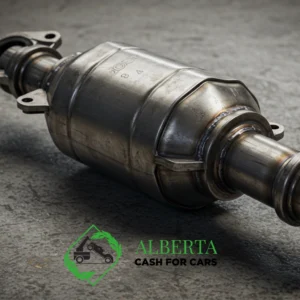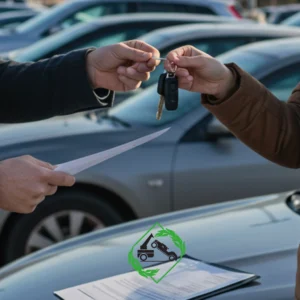Losing a loved one is a difficult experience, and dealing with their estate can feel overwhelming. Among the tasks you might face is figuring out what to do with an inherited car. This process can seem complicated, but with the right information, you can navigate it smoothly. If you’re wondering how to sell an inherited car, you’re in the right place.
It’s not just about the paperwork, though. It’s about handling this task with sensitivity and ensuring you’re doing everything correctly. Selling a car is a significant transaction, and inheriting one adds a few extra steps. So, let’s break down the process and make it as straightforward as possible.
No Hassle, Just Cash — Book Your Free Pickup or Quote Today!
Gathering the Necessary Documents: Building Your Foundation

Before you can even think about finding a buyer, you need to gather the right documents. This is the foundation of a legal and hassle-free sale.
- Death Certificate: You’ll need the original death certificate or a certified copy. This proves the owner is deceased.
- Proof of Executor/Administrator: If you’ve been named the executor of the estate or appointed as the administrator, you’ll need documentation to prove this. This might be letters testamentary or letters of administration from the probate court.
- Vehicle Title: The original title is essential. It needs to be in the name of the deceased owner.
- Registration: The vehicle’s registration can also be helpful.
- Affidavit of Inheritance (if applicable): Some jurisdictions have a specific form, an affidavit of inheritance, that simplifies the transfer of ownership for inherited vehicles. Check with your local DMV.
Having these documents in order is the first crucial step in learning how to sell an inherited car.
Navigating Probate: Understanding the Legal Process

Depending on the size and complexity of the estate, you might need to go through probate. Probate is the legal process of validating a will and distributing assets.
- Small Estate Affidavit: In some cases, if the estate is small enough, you might be able to use a small estate affidavit, which is a simpler process than full probate.
- Probate Court: If probate is required, the court will appoint an executor or administrator who will have the legal authority to sell the car.
- Transfer of Title: Once the probate process is complete, the court will issue documentation allowing you to transfer the title to yourself or directly to the buyer.
Understanding the probate process is key to legally selling an inherited vehicle.
Getting the Car Ready for Sale: Making a Good Impression
Once the legal aspects are handled, it’s time to prepare the car to attract potential buyers. Start by cleaning it thoroughly, both inside and out – a clean car always makes a better impression. Address any minor repairs that could deter buyers, such as a broken taillight or a loose trim piece. Gathering any maintenance records, like oil changes, can significantly increase buyer confidence. Finally, consider investing in a professional detail; it can make the car shine and is often well worth the cost. Presenting the car in its best possible light is absolutely crucial for a successful sale.
Determining the Car’s Value: Setting a Fair Price
Pricing the inherited car correctly is essential for a quick and successful sale. Start by doing thorough research, checking online resources like Kelley Blue Book, Edmunds, and local listings to see what similar cars are selling for. Carefully factor in the car’s condition, its mileage, and any special features it might have.
Also, consider the demand for this type of vehicle in your local market. Setting a fair price, based on these factors, will attract potential buyers and significantly increase your chances of selling the car in a timely manner.
Finding a Buyer: Exploring Your Options

Now it’s time to find someone who wants to buy the car. You have several options:
Private Sale: Reaching a Wider Audience
Taking the private sale route involves listing the car yourself, either online through platforms like Craigslist or Kijiji, or in local classifieds. This approach can potentially yield a higher selling price, as you’re dealing directly with individual buyers. However, it also requires more effort on your part. You’ll need to write a compelling listing, take good photos, answer inquiries from potential buyers, and be prepared to show the car. It’s a hands-on approach that can be rewarding if you’re willing to invest the time and energy.
Related Post:
Dealership Trade-In: A Convenient Option, Especially for a New Purchase
If you or someone you’re helping is purchasing a new vehicle, trading in the inherited car at the dealership can be a convenient option. Dealerships will assess the value of the trade-in and apply it towards the purchase of the new car. While you might not get the absolute highest price compared to a private sale, the process is generally straightforward and saves you the hassle of finding a separate buyer. This can be a particularly good choice if speed and convenience are top priorities.
Cash for Cars Services: Quick and Hassle-Free
For a quick and convenient way to sell an inherited car, especially if it’s older or has some issues, consider cash for cars services. These companies specialize in buying vehicles in any condition and often offer a very straightforward process. They typically handle all the paperwork, making it a very hassle-free experience.
If you’re in Alberta and are looking for a quick and easy way to sell an inherited car, reaching out to Cash for Cars Calgary could be a good option. Alberta Cash for Cars provides a transparent process and can handle the necessary documentation efficiently. This can be a great choice when speed and simplicity are paramount.
Completing the Sale: Ensuring a Smooth Transaction
Once you’ve found a buyer and agreed on a price, it’s time to finalize the sale.
- Bill of Sale: Create a written bill of sale that includes the names of the buyer and seller (you, acting on behalf of the estate), the vehicle details, the sale price, and the date of the sale.
- Transfer of Title: Follow your local DMV’s guidelines for transferring the title. You’ll likely need to provide the death certificate, proof of executor status, and the title.
- Secure Payment: Ensure you receive payment in a secure form, such as a certified check or bank transfer.
Completing the sale correctly protects both you and the buyer.
Notifying the Authorities
After the sale is complete, there are a few more steps to take.
- Notify the DMV: Inform your local DMV that the car has been sold.
- Cancel Insurance: Cancel the insurance policy on the vehicle.
- Remove License Plates: Remove the license plates from the car.
These steps ensure the estate is no longer responsible for the vehicle.
Handling Sentimental Value: A Personal Consideration
Selling an inherited car can be more than just a simple transaction; it often involves deeply felt sentimental value. It’s perfectly okay to feel emotional about selling a car that belonged to a loved one, and acknowledging these emotions is an important part of the process. If the sentimental value is particularly high and you have the means, you might even consider keeping the car.
Whether you decide to sell or keep it, taking photos of the car and sharing stories about it can be a meaningful way to preserve the memories associated with it. Recognizing and addressing the emotional aspect of selling an inherited car is a crucial part of navigating this task with sensitivity and care.
Final Word
Selling an inherited car is just one piece of the larger puzzle when it comes to settling an estate. It’s understandable if the process feels overwhelming, so remember to take it one step at a time. Don’t hesitate to reach out for help from family, friends, or professionals when you need it. By following the steps outlined, you can navigate the process of how to sell an inherited car with confidence and ensure a smooth and successful sale. Be patient with yourself, allow time to grieve, and know that you will get through this. This is a journey, and you’re not alone.







